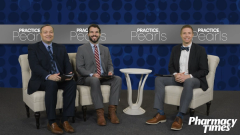
Clinical and Operational Differences: Proteasome Inhibitors Versus AntiCD38 Antibody Therapies
Experts navigate the impact of proteasome inhibitors and anti-CD38 antibody therapies in the relapsed refractory multiple myeloma treatment landscape.
Episodes in this series

Ryan Haumschild, PharmD, MS, MBA: When we think about the different treatment options, I have heard a lot of people talking about proteasome inhibitors and anti-CD38 antibodies. Dr Hinojosa, could you give us an overview of what clinical and operational differences we’re seeing in proteasome inhibitors compared [with] the anti-CD38 antibody therapies in our patient populations [with] relapsed refractory [disease], and [regarding] the clinical and operational differences, what role does administration play in the selection of therapies?
Gabe Hinojosa, PharmD, BCOP: Any time we’re going to bring a new drug and offer it to our team and say, “Hey, we want to start using this at our center,” the first question we’re asked is, “What are those operational challenges going to be?” And that’s a great job for the pharmacists to think through [on] that team. So we see a lot of changes in differences operationally between the different drugs. You hinted at some in the question, but one of the primary drivers of those operational differences is the route of administration. Luckily, with both classes [of] our anti-CD38 antibodies and our proteasome inhibitors, we have multiple options for routes of administration. We’re comparing apples to apples, potentially with 2 drugs, 1 in each class that could both be given subcutaneously, [eg], subcutaneous daratumumab for our CD38 antibodies and subcutaneous bortezomib from our proteasome inhibitors. Operationally, they’re going to be similar except for some of the prolonged chair time that [the] patient may have with the first few doses of daratumumab to make sure we’re not having any type of immune response or infusion response to that antibody therapy. In that scenario, that subcutaneous proteasome inhibitor can shine operationally because we’re expediting administration; there’s not a prolonged patient monitoring period afterward. When we get to therapies that offer an oral route of administration, some of our proteasome inhibitors that could be administered orally are the ones [for which] our administrators always love to hear our formulary review. Because operationally, it doesn’t require much from our infusion centers, and we’re able to get patients in and out and treated more efficiently and ultimately treat more patients in that same period of time. Often when we’re considering the route of administration, one of the biggest questions, at least from the patients and the caregivers when they hear that they’re receiving an intravenous [IV] therapy, is, “How long is my chair time? What is the stay going to look like each time we come? How long will my family members have to take off to be here with me and to drive and things like that?” And even in that scenario, our IV proteasome inhibitors are smooth from an operation standpoint. With IV carfilzomib being a quick infusion relative [to others in] the oncology space, just a 10- to 30-minute infusion, we can get those patients treated efficiently and effectively without too much of a drag on the system. From the clinical standpoint, however, we can see some changes between the classes. We’ve alluded to it some in some of our previous discussions, but our CD38 antibodies tend to be a milder [treatment for] the patient [with] regard to potential toxicities, outside of that initial risk, albeit low for infusion-related reactions, especially in the subcutaneous administration. There’s not a lot of additional monitoring or things to counsel and educate the patients [about]. Whereas with some of our proteasome inhibitors, we see some of those clinical impacts from both an efficacy standpoint and a toxicity standpoint. So it’s [about] weighing those pros and cons and always looking at that big picture of help vs harm. So we’ve discussed, especially in some of those patients with high-risk [disease], that proteasome inhibitors are an excellent choice and are very effective in those patients. But with that additional efficacy does come some risk for additional toxicity as well.
Ryan Haumschild, PharmD, MS, MBA: I like that breakdown because it’s so important as we’re evaluating the entire product for the patient. And I really like how you homed in on the subcutaneous administration. There are a lot of benefits for patients, those [who] might be coming in [who] might be actively working, or even for a health care facility to have a faster turnaround time so a patient can get in and out and they can have the capacity to see more patients. I have seen that revolutionize care, and we’re starting to see subcutaneous as a form of administration start to infiltrate a lot more therapeutics within the hematologic [malignant tumor space].
Transcript edited for clarity.
Newsletter
Stay informed on drug updates, treatment guidelines, and pharmacy practice trends—subscribe to Pharmacy Times for weekly clinical insights.

















































































































































































































